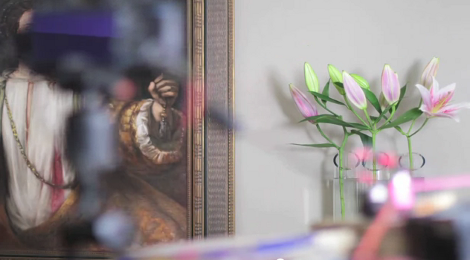
It’s neat to watch these lilies open and close during the time-lapse movie. But what makes it even better is to see the camera slowly move during the time-lapse event. It’s thanks to a special dolly which the photographers built for this purpose.
The system is based on two curved and inclined pipes which make up the rails of the system. The dolly that rides along the rails has a geared motor on it which turns at 2 RPM. This is used as a winch, spooling a string that is tied to the high-end of the rail system. As the winch winds the string, the dolly slowly moves along the track.
To make this work over multiple days they covered all of the windows in foil and lighted the room with fluorescent fixtures. An intervalometer was used to trigger the camera every three minutes. An Arduino monitors the camera’s shutter LED via a light dependent resistor. Sixty seconds after an image is take the Arduino will drive the dolly motor for a few seconds
The finished video, as well as a hardware show-and-tell, can be seen after the break.
















too bad the clip is shorter than the time it took me to read the article !
If you look at the last shot you can watch the water going down in the vases!
Yes! That is what I was more impressed by, actually. Especially impressive since they aren’t any roots!
nice, reminds me of all the hd bbc style documentaries
That’s a sick rig.
Is no one worried about the chap at the window? He’s got a knife and you can tell by his eyes he wants the lilies.
Always love to see any photography and video projects on here.
This is a very impressive build, the movement is smoother than I thought possible without using stepper motors or some kind of feedback sensor!
Ive been thinking about trying something like this but i don’t have an Arduino (thinking about a RPi tho). I have a couple of suggestions for anyone wanting to try something like this:
You can use the PC socket(http://en.wikipedia.org/wiki/Prontor-Compur) that most cameras have, to detect the shutter firing. Its basically two pins that the camera shorts to fire a flash when the shutter opens, you can use the center and ground pins on a hot shoe in the same way. This way you don’t need to read the card access led on the back of the camera.
Also the delay and motor timing can be done with a 556 ic. One side controls the delay to ensure the shutter has time to close and then triggers the other side which runs the motor for a predetermined period.
At least that’s how i would try to do the same thing, using what i have to hand.
anyway, cool project! looking forwards to seeing more from these guys!